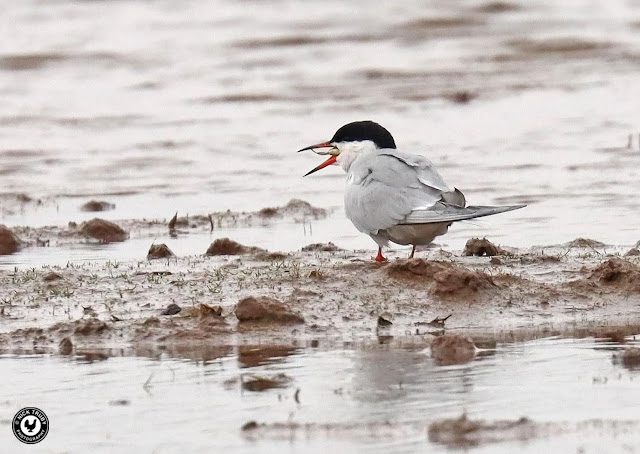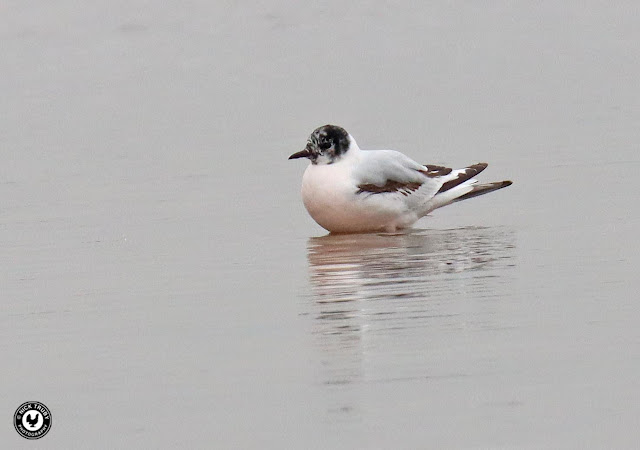The RSPB's reserve at Frampton Marsh on the Lincolnshire edge of The Wash is always worth a visit. It's a great place to add to a year list and to see a great variety of birds and there is usually something scarce or rare to observe. Another bonus is that it's only a couple of hours from home so we generally make a few trips there each year. After waking early on Saturday morning and not having made plans we discussed various options and realised that we hadn't been there for over nine months. Without even checking the latest sightings we left half an hour later and arrived by nine o'clock choosing to park in the seaward carpark which gives the quickest access to the seawall and what I consider to be the "business end" of the reserve. Only after I'd kitted up did I check the reserves Twitter feed to see what had been seen on the previous day. The star bird was a Temminck's Stint, in fact three had been seen on recent days, and they had shown mainly on the pools either side of the track just before the seawall so by sheer luck we had emerged in exactly the right place to look for them. Unluckily though, we had chosen to visit on a very damp and rain filled morning!
The viewing mound, a very thoughtfully installed hump of tarmac that raises the viewer up by a couple of feet and therefore allows a clearer view over the reeds that border the reserve was just thirty feet away. On our way to it we briefly stopped to watch a Sedge Warbler try its hardest to engage with another of its kind which tried its hardest to get away from it. The pursuing Sedge Warbler, maybe it was Reggie, last years star performer from Farmoor, wore a look of bemusement as it was consistently shunned by the other.
 |
| Sedge Warbler |
We reached the viewing mound and joined the only other birder in sight. Wet mornings are good at keeping a lot of people indoors and thus leaving the great outdoors to the intrepid types. After exchanging cordial greetings we asked what she'd seen and were told that a Temminck's Stint had just been showing really well on the edge of the scrape but had disappeared into the grass. Stints of all species are tiny birds, a size smaller than the usually acquainted Dunlins, so can easily vanish into low growing vegetation. Temminck's Stints are also well known for their crouching gait as they feed so are unobtrusive anyway. After ten minutes the shuffling and unremarkable looking wading bird re-emerged into view feeding along the muddy edge. We've seen a few Temminck's Stint (named after the Dutch ornithologist Coenraad Temminck) over the years but I've never claimed a really good photograph of one. I'm looking forward to seeing another one in the future so that I'll get another chance to get that cracking image but for now I added a couple more record shots to the portfolio. The Temminck's Stint was bird number 178 for the year.
 |
| Temminck's Stint |
Getting decent images of anything was going to be extremely difficult in the conditions but other birds were at least showing better and more openly. Avocets flourish at Frampton and can be encountered all over the reserve. An adult paddled past while scything through the water with its extraordinary up curved bill.
 |
| Avocet |
A small Gull flew past my right shoulder while I was searching again for the Temminck's Stint. Not immediately knowing what it was but knowing that it wasn't a Black-headed Gull and therefore something different, I decided that it needed checking out. I followed it as it flew across the track and when it thankfully landed at the back of the scrape opposite I was able to quickly get on it. A quick look through the binoculars revealed a fine first summer Little Gull. We'd already seen Little Gulls this year when we joined in on observing a mass influx of over eighty of them at Farmoor in April but this particular bird was at much closer quarters than any of those had been. We transferred to a viewing point on the other side of the track and enjoyed watching the dainty Little Gull pick flies, gnats and even small stones from the shallow water. At the range of just thirty metres or so, the pink blush to the underparts was very noticeable.
 |
| Little Gull |
The Little Gull took to flight and we watched in admiration as it expertly manoeuvred to collect airborne insects. The Gull would fly rapidly at a few metres elevation and then twist and turn to catch a fly. Sometimes it would dip down to the water to snatch food there. It was as dextrous as any Hirundine or Tern species at feeding in that fashion.
When the Little Gull flew out onto the main fresh marsh I turned my attention to watching the antics of a displaying male Redshank that was going all out to in an attempt to pair up with a female that generally appeared completely uninterested. Dispassionate female birds seemed to be the order of the day, it must have been the damp weather. The sideways running, neck stretching and wing flapping were all performed with great gusto but the female just looked bored. A video would have done the Redshank's performance a lot more justice than my still frame photos.
 |
| Common Redshank |
A little further along the grassland area I spotted a fairly large brown bird, a Whimbrel. Until very recently Whimbrels had always been a bit of a bogey bird for me and apart from when on Shetland twenty odd years ago, I'd never really gotten good views of one let alone managed to take a recognisable photo. This bird was close enough to gain great scope views. The rain that was falling steadily didn't help in the photographic stakes but the images I took were a hundred times better than anything else in my portfolio.
 |
| Whimbrel |
The rain abated a little so we walked up to the seawall. A surprise year tick came in the form of two Sandwich Terns that flew noisily overhead and that was quickly followed by another when I spotted a fine breeding plumaged Grey Plover by a pool on the salt marsh. Another quickly followed when a flock of Brent Geese flew in and landed in the same area that the Whimbrel was frequenting. We had only moved a hundred metres from the car all morning and yet had added five new species to the year list taking it up to 180. Frampton Marsh really is a brilliant place for birding.
 |
| Grey Plover |
 |
| Brent Geese |
Viewing from the seawall back into the marsh, I spotted a Curlew Sandpiper, again new for the year, in amongst a sizeable flock of Dunlin and Ringed Plover. As I raised the camera to take a record shot the flock were startled and flew back to the salt marsh. My photos taken in haste unfortunately didn't capture the Curlew Sandpiper.
 |
| Dunlin & Ringed Plover |
The rain that had been present all morning took a turn for the worst and increased in intensity. This had us scurrying for the sanctuary of the car. By the time we reached it we were pretty well drenched. We watched the rain rattle against the windscreen for a while wondering if we should just cut our losses and head home or elsewhere. As the rain eased a little, I could see lots of Swifts gunning low over the wetlands. I can't resist Swifts, they are one of the best species of birds for me, so I was out of the car trying once again to gain some more photos of them. The dingy light meant I had to ramp up the exposure to a maximum but I always have fun with Swifts and while Mrs Caley stayed in the dry car I fired off frame after frame as each Swift torpedoed towards me. Swifts are the most dynamic of birds so it always seems more than a bit incongruous to see a still frame of one since they are never actually ever still!
 |
| Common Swift |
 |
| Common Tern |
The Whimbrel was still stood on the same small patch of grass and at times crept a little bit closer to the road edge. At one point is was approached by a strange looking small wading bird with longish legs which after some deliberation I assumed must have been a funny looking long-legged Dunlin. If any Oystercatchers or Avocets or anything else wandered into the Whimbrels space then they were quickly moved out of it. This was a solitary Whimbrel and it determined to keep it that way.
A Temminck's Stint, maybe a different one from the one seen earlier, was also feeding on the grassy area but much further out than the first one seen. I wouldn't have bothered taking photos of it except for the fact that it scuttled behind a couple of bathing Brent Geese which gave a good idea of the size of the small wader.
 |
| Brent Geese & Temminck's Stint (centre background) |
The weather App that I have installed on my phone promised more wet weather for the rest of the day so we decided that we'd had enough. The precipitation was getting heavier again as I watched the Whimbrel and Stint so we thought better of it and geared up (down) to leave. We had added seven new birds (we'd also seen a couple of distant Spoonbills) for the year so were more than satisfied. Frampton Marsh is excellent in any weather, the birds are always there after all, it's just the viewing and photography that suffer in poor viewing conditions.
 |
| Oystercatcher |
We always turn right out of the entrance track because someone told us once that there are Little Owls residing in an old farm building about half a mile away. We've never seen them despite several attempts but they're still supposed to be there. We couldn't find them on this occasion either so turned around to head home. As we rounded a bend in the road, I spotted a bird perched on an overhead wire and I knew straight away what it was despite it being silhouetted and probably fifty metres away, a Turtle Dove! I've seen loads of Turtle Doves in exactly the same type of situation so it's become second nature to know them. Sadly there have been no substantiated reports of any from my local Otmoor this year so it was great consolation to see one here. We watched the Dove drop into the muddy field below the wires for a while and added it to the year list. It was our eighth year tick of the day and probably the most gratifying.
 |
| Turtle Dove |
The last birds we saw that day were a couple of Red-legged Partridges close to the roadside as we drove away. It had been another grand day on the edge of The Wash in spite of the dreary and wet weather.
 |
| Red-legged Partridge |






















No comments:
Post a Comment